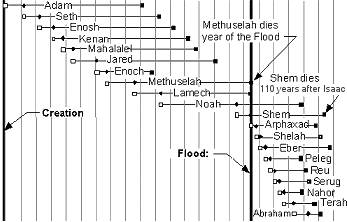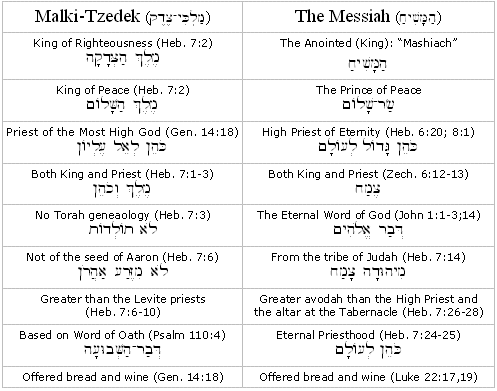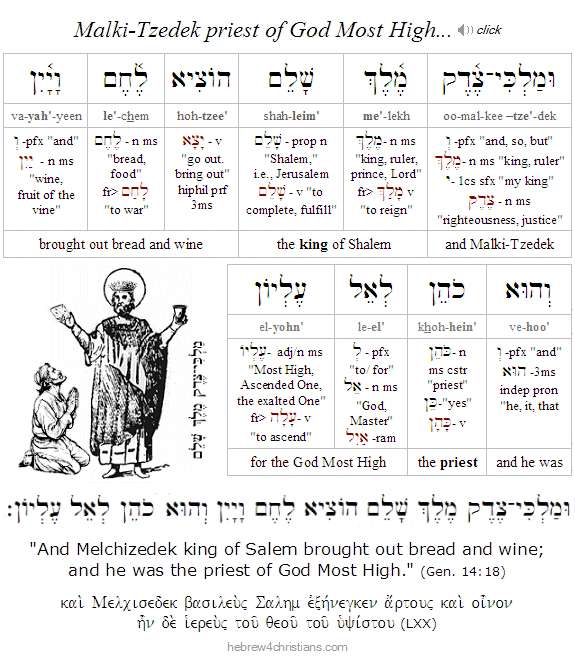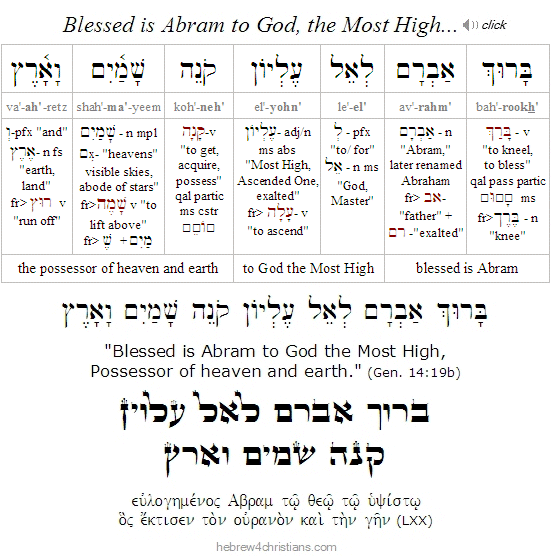|
AFTER ABRAM WAS GIVEN THE DIVINE PROMISE to inherit the land of Canaan (Gen. 13:14-18), the Torah gives an account of a regional war (near the Dead Sea) during which his nephew Lot was taken prisoner. When Abram learned of his nephew's abduction, he mobilized a small army of men and rescued him, supernaturally defeating King Chedorlaomer and his three vassal allies (Gen. 14:1-16). To honor his victory, the king of Sodom met Abram at the Valley of Shaveh (i.e., the "United Valley" just outside Jerusalem) and escorted him to the city of Salem (later renamed "Jerusalem"). It was here, at Salem, that "Malki-Tzedek" (מַלְכִּי־צֶדֶק), the high priest and king of the city, brought out bread and wine and blessed Abram (Gen. 14:18).
But who is this mysterious figure called Malki-Tzedek? The name "Malki-Tzedek" literally means "my king" (i.e., מַלְכִּי, from מֶלֶךְ, "king") is "tzedek" (i.e., צֶדֶק, "just, righteous"). Note that it does not mean "King of righteousness" (as is sometimes claimed by Christian theologians), since the word "malki" contains a possessive personal pronoun (i.e., "my king"). Jewish tradition identifies Malki-Tzedek as Shem (שֵׁם), the firstborn son of Noach, who settled in Salem (שָׁלֵם) some time after the great Flood. To understand how Shem became the first high priest and king of Zion, we need to go back and reconsider the lineage of the patriarchs.

Adam was the world's "firstborn son" (bechor) of God (Gen. 2:7, Luke 3:38). After his transgression (and exile from the garden), Adam built an altar and offered sacrifices to the LORD as humanity's first high priest. When he later died, Adam's son Seth (שֵׁת) became high priest in his place. When Seth later died, the priesthood went to Methuselah (מְתוּשָׁלַח) who served for centuries. Methuselah was prophesied to die seven days before the advent of the great Flood, and upon his death his grandson Noach (נחַ) was commissioned to be humanity's high priest. Noach had learned the laws of sacrifice ("clean" and "unclean") from the books of Adam and Enoch as well as from his grandfather (Gen. 8:20). After the Flood, Noach rebuilt Adam's original altar in Jerusalem (which had been destroyed earlier by wicked people of the generation of the Flood). Later, however, he was disqualified to be priest and his firstborn son Shem (שֵׁם) took his place. Shem remained in Jerusalem (i.e., Salem) and became its king and high priest. The name "Malki-Tzedek" was later ascribed as an honorary title (perhaps similar to the title Adonai-Tzedek as mentioned in Josh. 10:1).
Now Shem was truly an extraordinary person. He was the firstborn son of Noach who personally served the great patriarch Methuselah for 98 years before the Flood (Methuselah, it should be noted, directly knew Adam). And Shem had witnessed -- firsthand -- the devastation of the Flood and God's judgment upon the world. After the deluge, he settled in Salem where he founded a school for Torah study to encourage his descendants to serve the LORD. According to tradition, Shem was present at the brit milah (circumcision) of Abraham and Ishmael (Gen. 17:23), and later Isaac studied with him after the Akedah ordeal (Gen. 22:1-14). Still later, Isaac's wife Rebekah went to visit him regarding the struggle of her pregnancy and was given the prophecy of the "elder serving the younger" (Gen. 25:22-23). And when Jacob finally "stole" the blessing from Esau, he fled from his brother by going first to Shem's school in Salem. So all three of the avot (patriarchs) of Israel -- Abraham, Isaac, and Jacob -- personally knew Shem.
Shem is considered one of the four righteous men of the "dispersion" period (i.e., the period after the Flood in which the descendants of Noah were to commanded to settle the earth). The thee others are Noach, Eber, and Abram. For 400 years Shem preached to the idolaters of the world, calling them to repentance and offering instruction at his school in Salem. He was a prophet who foresaw the future glory of Zion -- God's Temple and the redemption of the human race. He wanted to establish the kingdom of God based on justice (tzedek) and peace (shalom).
According to the sages of the Talmud, God originally planned to bring forth the priesthood through Shem, but he was disqualified because he had blessed Abram before God ("blessed be Abram ... and blessed be the Most High God," see Gen. 14:19-20). Because of this misstep, the LORD decided to bring the priesthood through Abraham's offspring (i.e., Levi). Indeed, the sages interpret David's later statement, "You are a priest forever after the order of Melchizedek" (Psalm 110:4) as, "You are a priest forever because of the words (al-divrati / עַל־דִּבְרָתִי) of Malki-Tzedek" (Bava Batra 14b). Shem had got his priorities mixed up and put Abram before the LORD, and that displeased God. Moreover, the sages note that Shem understood God primarily as El Elyon (אֵל עֶלְיוֹן), the supreme God among other gods (elim), but Abram put the LORD first ("I have lifted my hand to the LORD, God Most High..." Gen. 14:22). In other words, Shem's idea of God was of a Supreme Being, Creator, and Judge, but Abram understood God as the personal LORD (יהוה), the compassionate Source of life. Abram understood the LORD as the God of human providence and care, not just as the Judge of the earth.
As already mentioned, Abram and Shem knew each other, though after the "war of the kings," they were said to be fearful of one another. Abram was said to be fearful that Shem would resent him for killing his descendants (Chedorlaomer was a direct descendant of Shem), whereas Shem was fearful that Abram was angry over the abduction of Lot and the need for war. The offering of bread and wine therefore represented a "peace offering" between the two. Moreover, Shem was further revealing to Abram the laws of the high priesthood. The bread represented the "bread of faces" (לֶחֶם פָּנִים) or "showbread," and the wine represented libations or drink offerings (נֶסֶךְ), both of which became part of later Temple worship. Abram's victory was sanctified by the high priest of God, and Abram's tribute was given to honor God's representative.
Hebrew Lesson
Genesis 14:18 reading (click):
Malki-Tzedek may have been the historical Shem, though מַעֲשֵׂה אֲבוֹת סִימָן לַבָּנִים / ma'aseh avot siman labanim: "The deeds of the fathers are signs for the children." In other words, like other "types" or patterns given in Scripture (e.g., the sacrifice of Isaac), there is a deeper significance to the immediate historical context. The fusion of a King-Priest that predates Israel is a picture of the Messiah himself, as was foreseen by the prophets.
For example, the name Adonai Tzidkenu (יְהוָה צִדְקֵנוּ), "the LORD our Righteousness," appears in Jeremiah's prophecy of the "righteous branch" (tzemach tzaddik, צֶמַח צַדִּיק), the great Davidic King who was promised to appear (Jer. 23:5-6). This "Righteous Branch" is also mentioned in Book of Zechariah as the one who would ultimately unite the authority of the priesthood with the Kingship of God on behalf of Israel's redemption.
Although Jewish tradition regards Malki-Tzedek to be the patriarch Shem, he is clearly a picture of Adonai Tzidkenu. He is called the "King of Righteousness and priest of the Most High God" (Gen. 14:18-20; Psalm 110:4; Heb. 5:6). The Midrash Lamentations says, "The proper name of Messiah is Adonai Tzidkenu - the Lord our righteousness." Note that the very first occurrence of the word "priest" in the Scriptures occurs in reference to the King/Priest Malki-Tzedek – a picture of the coming Tzemach Tzedakah, Yeshua the Anointed One.
The New Testament calls Yeshua Adonai Tzidkenu and declares Him the only True Tzaddik (1 Cor. 1:30; 1 John 2:1) since He alone truly fulfilled the Torah of Moses and gave Himself as a sacrificial offering upon the cross to save the world from the judgment of God (2 Cor. 5:21; John 3:36). Those who trust in Him are also justified as tzaddikim, since "the tzaddik shall live by faith" (Hab. 2:4, Rom. 1:17, Gal. 3:11).
In short, Adonai Tzidkenu is the name for Yeshua who "saves His people from their sins" (Matt. 1:21). The righteousness of Yeshua is the gospel message itself, that is, the power of God to save us from the verdict of our sinful condition and to restore our relationship with a holy and morally perfect God. God will not clear the guilty, but He does something infinitely better: He removes the guilt! The curse of the Law's verdict upon us has been taken away through the substitutionary sacrifice of Yeshua upon the cross at Moriah (Gal. 3:13; 2 Cor. 5:21). God puts our sin upon Yeshua and gives us His righteousness in exchange. By sincerely turning to Him in confession of our condition and trusting in His righteousness we are declared legally "justified" (i.e., "just-if-I'd" never sinned) before the Judge of the World. Moreover, through our union with Yeshua, we share in the vindication of His resurrected life and have peace with God (Rom. 5:1). To be justified is to share in Yeshua's righteousness: Adonai Tzidkenu!
Of course the Book of Hebrews also links the priestly work of Yeshua as our Kohen Gadol of the New Covenant with Malki-Tzedek (Heb. 5-10). Malki-Tzedek is said to have been "made like" (ἀφομοιόω) the Son of God, "having neither beginning of days nor end of life" (Heb. 7:3). This Greek word means "to resemble" or "to liken" (from ἀπό + ὁμοιόω). The priesthood of Yeshua is said to be after the "order of Malki-Tzedek," based on a direct oath from God, that predates the operation of the Levitical priesthood (for more information about the role of Yeshua as our High Priest, see the article "Yom Kippur and the Gospel"). This is not unlike the King/Priest office that Moses held when he commanded the sacrifice of the Passover lambs during the Exodus. The korban pesach (sacrifice of Passover) was not originally instituted through the Levitical priesthood (i.e., the Mishkan), but rather predated the giving of the law to the priests.
Yeshua is Adam ha'acharon - "Final Adam" (אדם האחרון) - who offered up a better sacrifice upon the altar of the Cross in Jerusalem (1 Cor. 15:45). He is humanity's great High Priest (Kohen Gadol) of the New Covenant with God. Like Malki-Tzedek, Yeshua's priesthood abides forever and is more profound than that given through the Levitical rites. Yeshua "ever lives to make intercession for those who trust Him as their Advocate" (Heb. 7:25).
Hebrew Lesson
Gen. 14:19b reading (click):
Note: Some Christians have objected to the idea that Shem, Noah's heir, could also be "Malki-Tzedek," the King of Salem to whom Abraham later gave tithes. To understand how Shem became the first high priest of humanity and king of Zion, we need to go back and reconsider the lineage of the patriarchs (see diagram above) and to realize that Shem was the appointed heir and firstborn priest (bechor) of all of humanity. In Psalm 110:4 we read a prophecy of Yeshua our Messiah: "The LORD has sworn and will not change his mind, "You are a priest forever after the order of Melchizedek." If you look at the Hebrew in this verse you will note the phrase עַל־דִּבְרָתִי מַלְכִּי־צֶדֶק / al-divrati malki-tzedek, "according to the word or manner of Malki-Tzedek" calls for some interpretation. The NT translates this phrase as κατὰ τὴν τάξιν Μελχισέδεκ, the keyword here being τάξις ("arrangement, order"), and the Book of Hebrews further says that Yeshua came "in the similitude" or "likeness" (ὁμοιότης) of Malki-Tzedek, not that He is Malki-Tzedek. Moreover, Malki-Tzedek is said to have been "made like" (ἀφομοιόω) the Son of God, "having neither beginning of days nor end of life" (Heb. 7:3), but again it does not explicitly say He is the same person.... In other words it is entirely possible that Malki-Tzedek was both a historical person and a picture or "parable" of Yeshua as the great High Priest and King to come. Yeshua came after "the order (τάξιν) of Malki-Tzedek" (Heb. 6:20), a term that may refer to the original office or position as the high priest of God, a role Yeshua assumed as the Son of Man...
 |
|






